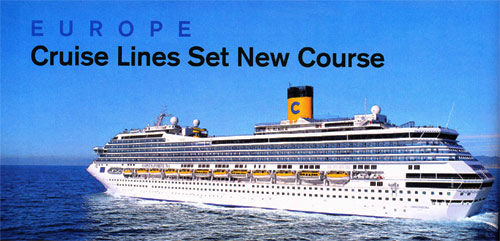 As the 2004 European cruising season is in full swing, the market has changed dramatically from 2003 and 2002. Instead of a variety of European companies competing mostly in national markets and some on a pan-European basis, most of the strongest national brands are operating under the Carnival Corporation umbrella, with a combined fleet of 22 ships and a passenger capacity of 1.3 million passengers, commanding a 43.3 percent market share.
As the 2004 European cruising season is in full swing, the market has changed dramatically from 2003 and 2002. Instead of a variety of European companies competing mostly in national markets and some on a pan-European basis, most of the strongest national brands are operating under the Carnival Corporation umbrella, with a combined fleet of 22 ships and a passenger capacity of 1.3 million passengers, commanding a 43.3 percent market share.
Carnival brands dominate the U.K. market – with P&O Cruises, Ocean Village , Swan Hellenic and Cunard Line in addition to a dedicated Princess Cruises ship – covering a range of market segments.
Changes
Sun Cruises, which pioneered affordable cruising in the U.K. , has decided to throw in the towel, leaving Thomson Holidays as the leading tour operator with a major cruise involvement. It was only a few years ago that seemingly every British tour operator was following in the wake of Sun Cruises (then Airtours, now MyTravel).
The U.K. market produced some 960,000 passengers in 2003.
The largest operator in Italy is Carnival’s Costa Crociere, which reported a record year in 2003, carrying 557,300 passengers, and will be able to carry some 625,000 passengers in 2004, according to Cruise Industry News (CIN) estimates. But rivaling Costa in Italy and elsewhere may soon be MSC Cruises, which has set as its goal to have a fleet equal in size to Costa, but with newer ships, before the end of the decade.
In Germany , another Carnival brand, AIDA is the dominant cruise line, by far the largest operator in the market and the only one with new ships and plans to build more. Approximately 537,000 Germans cruised in 2003.
In Spain , which produced some 200,000 passengers in 2003, Spanish Cruise Line and Pullmantur have a total of four ships dedicated the Spanish market.
The only major market in Europe without a dedicated mainstream cruise line is France .
Market Potential
European markets are expected to produce upward of an estimated 3.0 million passengers in 2004 – or approximately 1.0 percent of the population of Western Europe , which is about 300 million. If the market is extended to Eastern Europe and Russia , the market population grows past 500 million and the percentage of cruisers drops to 0.6 percent.
By comparison, about 8.5 million Americans are expected to cruise in 2004 – or approximately 2.8 percent of the population.
If North America can be used as a yardstick, the European markets hold the potential to generate many more times its 2004 passenger-level.
Europe differs from North America , however, in that income levels are lower on the average, and vacation patterns are different. But a more important hindrance to growth is the lack of year-round cruising that is easily accessible. European lines are working to overcome this by deploying more ships in the Mediterranean year-round, as well as in the Canary Islands .
While the Eastern Caribbean and the Middle East would be an obvious winter destination, it is presently not a viable option for equally obvious reasons.
Caribbean winter deployment depends on airlift – which adds cost to a cruise – and passengers’ willingness to fly, which has become an issue of a more recent nature. Winter programs in the Far East have generally not worked for the same reasons.
In addition, winter sailings in South America and in South Africa tend to cater to local markets.
Mainstream Cruising
Meanwhile, European cruise capacity will continue to grow – by an estimated 2.4 percent in 2005, 7.4 percent in 2006 and 4.8 percent in 2007 – based on existing newbuilding orders. But the growth rate is expected to accelerate based on the building plans of the major brands.
The growth will take place in the mainstream cruise markets – the so-called contemporary and premium market segments.
The European luxury and budget markets will see very little or no growth at all.
Niche cruising may see a boost – but not in the typical adventure or exploration type cruising, but instead in a no-frills, pay-as-you-go cruise concept planned by easyCruise for launch in 2005.
If the American market can be used as a yardstick again, the future belongs to the cruise lines that build big, new ships. In the North American model, the operators of older ships have foundered against the competition of new ships operated by much larger brands, which also benefit from economies of scale. The longevity of smaller operators will depend on the growth pace set by the new ships, and whether or not they are able to carve out their own niches.
It Can Get Choppy
The past couple of years have been stormy for several of the independent European cruise lines. Festival Cruises suspended operations this past winter and several of its ships have been sold at auction. Royal Olympic Cruises is operating on a limited basis and has been de-listed from the NASDAQ stock market. And more recently, Sun Cruises announced its withdrawal. A spokesperson told CIN that “cruising is simply no longer profitable for the company.”
But the big picture is promising and gearing up for a future growth course, European lines last spring launched the European Cruise Council (ECC) with 14 member cruise lines, including several U.S.-based lines, to represent the industry vis-à-vis European Community institutions and help promote cruises in Europe . The ECC has its offices in Brussels . – Oivind Mathisen
Excerpt from the Cruise Industry News Quarterly Magazine: Summer 2004



